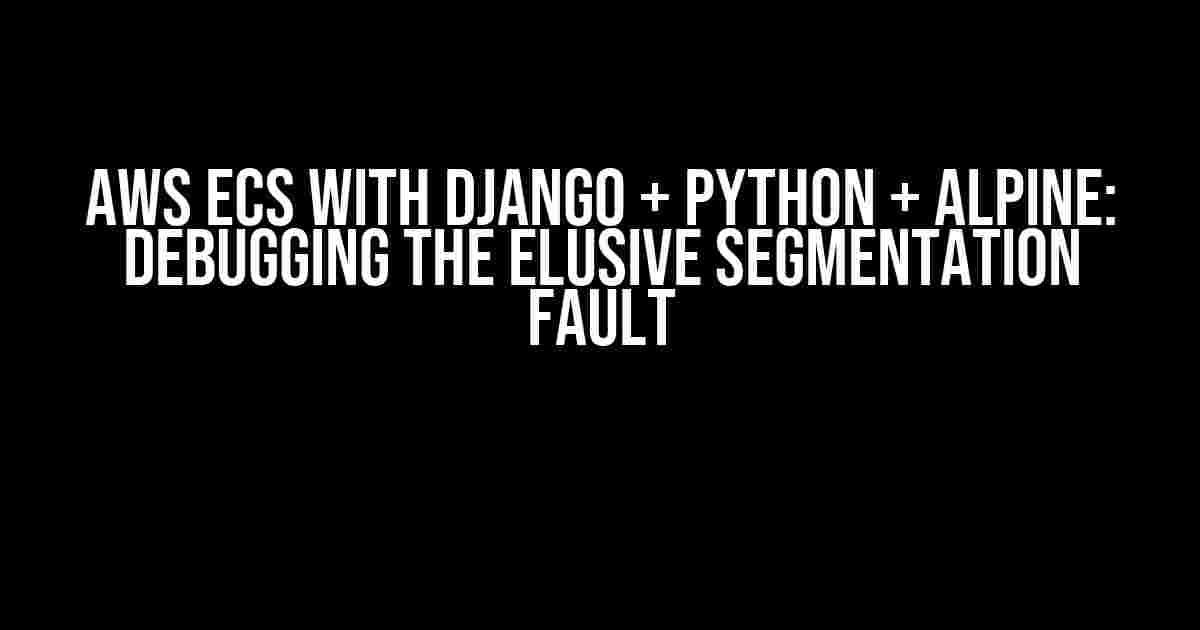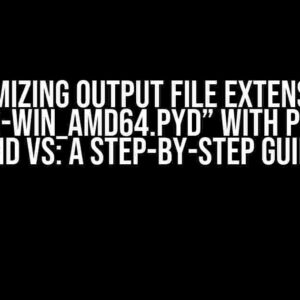Are you tired of scratching your head over the dreaded Segmentation Fault error when running your Django application on AWS ECS with Python and Alpine? You’re not alone! This article will take you on a journey to identify and resolve this pesky issue, saving you from the frustration and hours of debugging.
What is a Segmentation Fault?
A segmentation fault occurs when a program attempts to access a memory location that it is not authorized to access. This can happen due to various reasons, including:
- Invalid memory pointers
- Null pointer dereferences
- Array indexing errors
- Memory leaks
In the context of AWS ECS, Django, Python, and Alpine, the segmentation fault can manifest in different ways, making it challenging to diagnose and fix.
Setting Up the Environment
Before we dive into debugging, let’s ensure we have a clean slate. Follow these steps to set up a new AWS ECS cluster with Django, Python, and Alpine:
- Create a new AWS ECS cluster with the following configurations:
Configuration Value Instance Type t2.micro AMI Amazon Linux 2 Container Instance OS Linux - Install Docker on the instance:
sudo amazon-linux-extras install docker - Install the necessary packages for Django and Python:
pip install django python-alpine - Create a new Django project:
django-admin startproject myproject - Create a new Dockerfile for the project:
FROM python:3.9-alpine WORKDIR /app COPY requirements.txt . RUN pip install -r requirements.txt COPY . . CMD ["python", "manage.py", "runserver", "0.0.0.0:8000"] - Build the Docker image:
docker build -t myproject . - Create a new task definition for ECS:
Configuration Value Task Definition Family myproject Task Role ecsTaskExecutionRole Container Definitions - Container Name: myproject
- Image: myproject:latest
- Port Mappings: 8000:8000
- Create a new service for ECS:
Configuration Value Service Name myproject-service Task Definition myproject:1 Cluster mycluster Desired Count 1
The Segmentation Fault
Now that we have our environment set up, let’s introduce the segmentation fault. Run the following command to start the ECS service:
aws ecs start-service --cluster mycluster --service myproject-service --desired-count 1You should see the service start, but after a few seconds, it will fail with a segmentation fault error. The error message will look something like this:
container_linux.go:380: starting container process caused "exec: \"/usr/local/bin/python\": segmentation fault"This error indicates that the Python process is crashing due to a segmentation fault.
Debugging the Segmentation Fault
To debug the segmentation fault, we’ll need to dive deeper into the application’s logs. Run the following command to retrieve the container logs:
aws ecs describe-container-instances --cluster mycluster --container-instances arn:aws:ecs: region:account-id:container-instance/instance-arnIn the logs, look for any error messages related to the segmentation fault. You might see something like this:
File "/usr/local/lib/python3.9/site-packages/django/db/backends/postgresql/base.py", line 25, in
from .client import DatabaseClient
ImportError: /usr/local/lib/python3.9/site-packages/psycopg2/_psycopg.cpython-39-x86_64-linux-gnu.so: undefined symbol: PyCObject_AsVoidPtr This error message indicates that the psycopg2 library is causing the segmentation fault. This library is used for PostgreSQL connections in Django.
Resolving the Segmentation Fault
To resolve the segmentation fault, we need to upgrade the psycopg2 library to a compatible version. Run the following command to upgrade psycopg2:
pip install --upgrade psycopg2-binaryThen, rebuild the Docker image:
docker build -t myproject .Finally, update the ECS task definition to use the new image:
aws ecs update-task-definition --cluster mycluster --task-definition myproject:1 --requires-compatibilities EXECUTABLERestart the ECS service:
aws ecs update-service --cluster mycluster --service myproject-service --desired-count 1The service should now start successfully, and you should be able to access your Django application.
Conclusion
In this article, we’ve demonstrated how to set up an AWS ECS cluster with Django, Python, and Alpine, and debugged a segmentation fault error caused by the psycopg2 library. By upgrading the psycopg2 library and rebuilding the Docker image, we were able to resolve the issue and get the application running successfully.
Remember, debugging segmentation faults can be challenging, but by following a systematic approach and analyzing the application logs, you can identify and fix the root cause of the issue.
Frequently Asked Question
AWS ECS with Django + Python + Alpine can be a real challenge! Don’t worry, we’ve got you covered. Here are some common questions and answers to help you troubleshoot that pesky Segmentation Fault.
Q: Why am I getting a Segmentation Fault when running my Django app on AWS ECS with Alpine?
A: Ah, the infamous Segmentation Fault! It’s often caused by a mismatch between the Python version used in your Docker image and the one installed on your ECS instance. Make sure they’re aligned, and you might just find your app running smoothly again!
Q: How can I debug the Segmentation Fault issue in my AWS ECS with Django + Python + Alpine setup?
A: Debugging can be a real challenge! Try enabling core dumps in your Docker container and analyzing them with gdb or lldb. You can also enable debug logging in Django to get more insights. And, if you’re feeling adventurous, try running your app with the `–pdb` flag to get an interactive debugger.
Q: Is there a recommended Docker image for running Django with Python on AWS ECS?
A: Yes! For a hassle-free experience, use an official Python image as your base image. You can then install Alpine and Django on top of it. This ensures compatibility and reduces the chances of mismatched dependencies.
Q: What are some common gotchas when using Django with Python + Alpine on AWS ECS?
A: Watch out for outdated packages, mismatched library versions, and incorrect environment variables. Also, be mindful of the Alpine Linux’s musl libc, which can cause issues with some Python libraries. Lastly, make sure your ECS instance has enough resources (CPU, RAM, and storage) to run your app smoothly.
Q: Can I use a non-Alpine-based image for my Django app on AWS ECS?
A: Absolutely! While Alpine is a popular choice for its small size, you can use other base images like Ubuntu, Debian, or even the official Python images. Just ensure you’re aware of the implications on package dependencies and compatibility.



